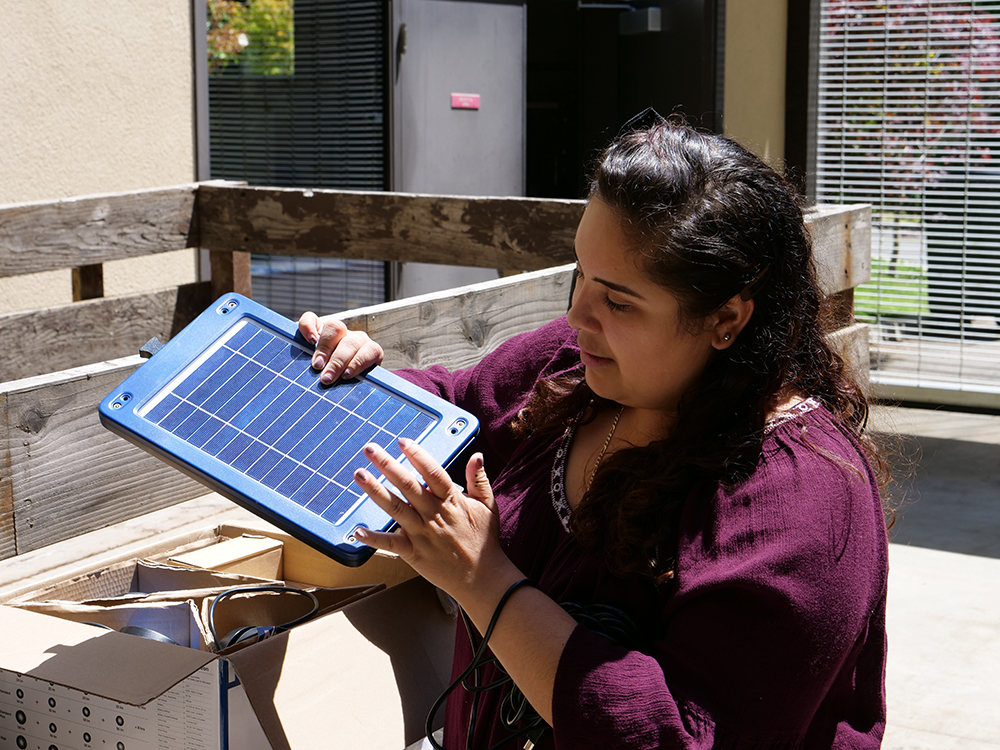This summer, thirteen students contributed to Schatz Center research projects in smart grids, bioenergy, wind, and off-grid energy access.
SMART GRIDS
Craig Mitchell provided construction observation at the Solar+ installation, tracking the canopy weight in real-time and serving as an onsite liaison between contractors and the Schatz microgrid team. As part of his observation, Craig recorded the installation’s actual daily labor and equipment requirements, to better define the needs for similar projects in the future. He is currently developing a hardware design toolkit that documents lessons learned in the Solar+ installation.

Thalia Quinn, Ellen Thompson and René DeWees have been developing a model to assess the current and future costs of building microgrids that integrate solar, battery storage, and fast EV charging. This model will help define which sites are good candidates for investment, and identify future research and development opportunities. This summer, the team conducted a detailed literature review to assess current and forecasted cost data: Thalia focused on battery storage, Ellen on electric vehicle charging infrastructure, and René on solar PV. They are now refining their cost model and generating a convenience store survey, to understand how current site owners view microgrids and to better assess installation opportunities.
Smart grid design is also evolving to take advantage of demand response technologies. As part of a collaboration with GE & Southern California Edison, Anh Bui developed an algorithm using Python code for estimating the tension between shifting a customer load to benefit the grid versus shifting a load to reduce their bill. Anh also helped with the installation of our new Schatz Solar Array in September.

BIOENERGY
This summer, Sabrinna Rios Romero quantified decay rates for the post-harvest residues of seven agricultural crops: corn, wheat, rice, cotton, almond, walnut and grape. These decay rates will allow us to better assess the greenhouse gas (GHG) emission implications of leaving residues in field versus converting them into electricity. This fall, Sabrinna is surveying state foresters to clarify the fate of forest residues — i.e. whether they are piled, burned, or scattered in the field — information which will allow us to more accurately assess emissions following forest harvest. She has also been analyzing biomass samples using a bomb calorimeter and a thermogravimetric analyzer, to measure the performance of a gasifier system.
Cassidy Barrientos conducted a literature review that characterized GHG emissions from wood chip storage (e.g. chip piles at a power plant). Decomposition during storage — and the resulting emissions — are an area that have not been well-quantified, and may represent an important source of greenhouse gases. In September, Cassidy and Schatz Faculty Research Associate Sintana Vergara presented a poster, “Characterizing greenhouse gas emissions from wood chip storage,” and gave an oral presentation “Waste not: Improving the efficiency of using forestry residues as an energy resource” at the ARI Principal Investigator’s Meeting in Sacramento.

Max Blasdel continued his ongoing work for the California Biopower Impacts Project. Max is characterizing the field decomposition of woody biomass residues left behind by forestry operations. His efforts comprise a key component of the business-as-usual case used to evaluate the net climate impacts of biomass removal for electricity generation. Max’s project research will form the basis for his master’s thesis in the Natural Resources program here at Humboldt State.
WIND ENERGY
Karsten Hayes developed an initial cost model (using Python and R) for north coast California offshore wind energy. The model includes associated storage needs, and integrates high-resolution offshore wind resource data from the National Renewable Energy Laboratory with load data for Humboldt County and California, drawn from Pacific Gas & Electric and the California Independent System Operator (CAISO).
OFF-GRID ENERGY ACCESS
Eli Wallach and Chih-Wei Hsu developed a method to estimate the number of fossil fuel generators used in low- and middle-income countries, how much electricity they generate, and how much fuel they consume. Their work supports a larger effort to estimate the economic, environmental and health impacts of fossil fuel generator systems used as a primary or backup source of electricity. To inform their assumptions and approach, they drew from multiple sources of data, including dozens of nationally representative household and business surveys. These data helped them understand the intensity of generator use at the country level, and in which sectors they are being utilized (i.e. commercial, residential). Eli and Chih-Wei’s fuel consumption estimates for over 130 countries are currently being utilized to update a widely used air quality and climate impacts model maintained by project collaborators at the International Institute of Applied Systems Analysis.
Schatz fellow Anamika Singh worked this summer with a team led by Dr. Amol Phadke at Lawrence Berkeley National Laboratory. Her research, which included collaboration with Dr. Phadke and Dr. Nikit Abhyankar, focused on identifying the parity price at which renewable energy technologies become feasible for heavy industries in India. Read more in our Fall 2018 From the Fellows report…
Chih-Wei and Anamika also helped with our Schatz Solar Array installation in September.
Tanya Garcia worked in the Schatz Center’s off-grid solar lab this summer, conducting solar product tests — including durability (drop and ingress), safety, and truth in advertising (light output, max power, full battery run time, etc.). She developed communications templates for the test lab network and edited specifications sheets to clarify product test policies. Tanya also helped test an open source electricity monitor, the EmonPi, and provided energy outreach activities for university and K-12 groups. Tanya is continuing her work in the off-grid solar lab this fall.














